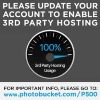spiker44
Member
Friend has a 7600 Gamemaster and put a set of see thru scope mounts on it. So since he couldn't bore sight down barrel he went and bought a bore sighting rig. The kind that has a spud and device that sit on the spud on the end of the barrel. You see a graph in the scope and center the cross hairs on the center of the graph. Ok. here is where it gets good. He bought this BSA bore sight kit for big bucks. Does what the instructions tell him to plus he read where he can set it higher for long distance shooting. I tell him to start at battle sight zero and work his way back making adjustments. He says no way man. I got it all zeroed in already. So off we go to the range. Start a the 100 yard marker and boom. Nothing on paper. half a box later, no holes anywhere but in the wind. So we move closer and closer until we are close enough to hit the target with the muzzle and it hits high. He tells me he is going to get a replacement for the bore sighter as he thinks it is broke. I try and tell him with the see thru mounts the plain of the scope is much higher than what the bore sighter was designed for. He tells me the POI still wont change no matter the difference between regular rings and see thru. I don't see it. It has to make a difference but maybe I am wrong. I only wish he just shot closer and worked his way back because it still is not sighted in because he ran out of rounds :banghead: Can this type of bore sighter be used for see thru rings and if so how?



 , I am going to print out all responses for him to read. Thanks guys..
, I am going to print out all responses for him to read. Thanks guys..